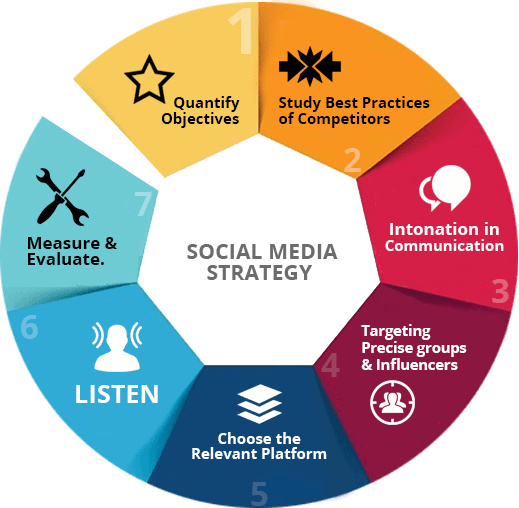There are several ways to present a social media strategy. The two perspectives in which they could differ in are:
1. Preparing a Social Media Strategy for your own brand
2. Preparing a strategy for a client
Marketers often approach social media without having a clear plan. You need to have a strategy in place that ensures clarity and sells well with internal and external stakeholders. Both of the above approaches require a concept direction that answers the following questions.

How to Document your social media strategy in 7 steps:
1. Understand Goals and Objectives
Social media goals can range from improving your share of voice to increasing and improving engagement, increasing followers and even improving sales & conversions and driving website traffic, to name a few. Although these are different objectives, they can be achieved well by studying the market and your competitors. Eg: Improving your share of voice and awareness may mean you are aiming at improving your brand mentions by 60 to 70%.
2. Know what your competitors are doing
Being aware of your competition is necessary. Taking into account as to what does well and what does not work for them gives you cues in order to cut through the noise and establish your unique brand picture in the social space. Following and engagement metrics, themes they use and their acceptance by the audience, having an understanding of their social referral traffic to websites and paid/organic mix of posts is something that can help you justify your approach.
3. Have a clear communication route
Work on a unique strategy or choose to ride with the tide – Now that you are clear with your goals and know what your competitors are doing, you need to define your approach with a selection of content buckets, tone of voice, themes/hashtags that you will want to use for social media positioning. These will be derived from your brand/product or seasonal time of the year.
Measuring the resonance of your approach can be derived by bouncing ideas with your team or brainstorming with other marketing teams. This will help you strike a balance of unique communication for your social media as well as applying some industry best practices that have worked for your competitors. The key while defining your communication strategy is to know your target group age and interests. It can be further simplified by defining brand personas. What is their ideal day, how do they spend their weekends, what is their cultural and family social and consumer behaviour, etc.
4. Ensure your mood board is self-explanatory
Images and creatives give a realistic understanding of how your plan will actually look. Your audience will have a strong call to action when your Images draw enough attention and further curiosity to your content. As a social media manager this mood board is a tangible direction to both your content writer and more importantly to your designers or creative agency. Your mood board could have cues of Rich media content like animated formats and video as well.
5. Choose the right platforms
You need to know where you want to be, know where your target audience interacts, and know what they are looking for depending on the platforms of choice. Your cross-platform strategy will include differentiation of content buckets or consistency in content themes for Facebook, Instagram, Linkedin, Twitter etc.
Tip: Do not feed content on platforms which make your message irrelevant. Relevance is key to have your social media engagement engine working at optimal levels on all platforms.
6. Calibrate your Listening
Social listening is often missed while creating a strategy. Understanding your users’ behaviour and knowing how to treat comments and messages via spontaneous replies, automated replies, or templates for expected positive/neutral/negative comments is necessary. Using of listening tools and creating alerts for keywords will help you track mentions in real time, measure online brand sentiment as well as check your share of voice versus competitors. A good listening tool improves turnaround response time as well.
7. Monitor Metrics
Remember to measure your impact of social media efforts and state the estimates you would like to achieve with regards to Following, Engagement, Reach, Demographics, Share of Voice, Sentiment and Actions in terms of clicks and referral visits.
